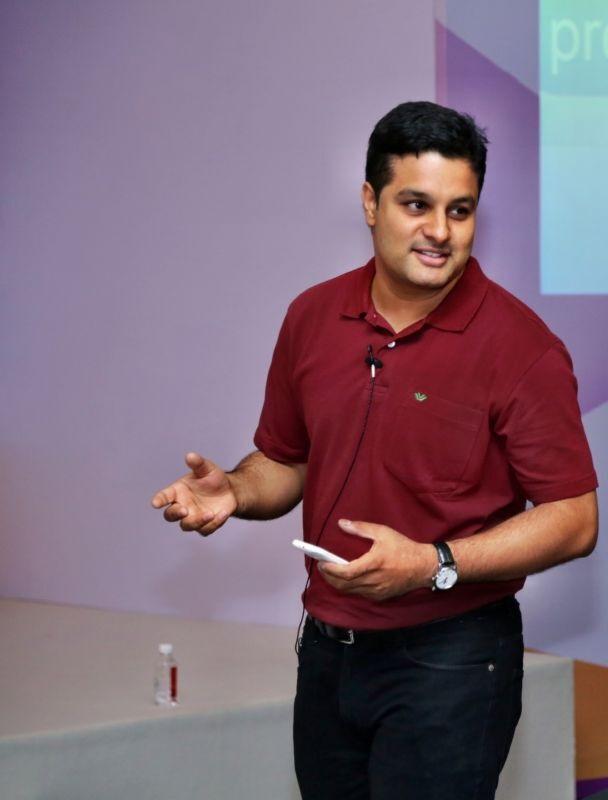Welcome to the next instalment of our ongoing Disruption Debate series. This time, Lars Hyland spoke to Sunder Ramachandran, General Manager – Training at GlaxoSmithKline (GSK) Pharmaceuticals India.

Sunder leads the commercial training strategy for GSK in India for over 3,500 employees and is particularly interested in social learning and mobile learning.
Pockets of excellence
“When you look at large organisations with hundreds of thousands of employees globally, you find that different markets are at different levels of maturity. There are pockets of excellence in these large companies, but we’re not all at a certain standard yet.”
Sunder is very well placed to talk about the South Asian e-learning market, with his many years of experience working in senior L&D roles in India.
“For instance, we are very mobile-first in India. The growth of mobiles across the last four or five years is significant – we leapfrogged desktop computers directly into mobile technology, unlike most western countries.
“As is true in many countries, there are more phones than people in India, and from a market standpoint, access to data across the country is becoming very affordable. 4G has been around in the west for several years, but now it is becoming prevalent in India.
“Access and affordability has made this mobile prevalence possible – 60% of the population in India is under 35, and lots of millennials entering the workforce has created a very conducive ecosystem for mobile learning.”
Putting mobile first
As Sunder points out, many countries transitioned first from traditional face-to-face training to desktop-based e-learning before eventually arriving at mobile learning, whereas for many organisations in India, their first digital learning experiences are likely to take place on mobile devices.
For Sunder, with 80% of GSK employees in his region being salespeople, creating top-quality mobile learning is critical.
“The key mistake that organisations make is ‘making e-learning available on mobile’ – which is definitely not the same as mobile learning. In my mind, the real value of mobile is in microlearning and performance support.
“At GSK India, sales reps use an app to record video simulations of their colleagues in the field. These videos can then be assessed by their managers. This is a great use of mobile that extends beyond e-learning.”
When designing mobile learning, Sunder recommends looking at each platform as a pitstop within the learning journey.
“When a new individual joins GSK, they get access to mobile learning apps and basic information about the company. The new salesperson is then sent to shadow an experienced salesperson in the field, and they are then sent to a 15-day bootcamp, which is then followed up with e-learning, mobile learning and pitching contests.
“We’re moving away from learning events and towards learning journeys which keep learners engaged over a longer period of time.”

“Learning should be a drip-fed, not like drinking from a hosepipe”
Where are learning systems heading?
“My personal view is that there is never going to be one system that does it all,” said Sunder, “meaning we must be comfortable setting up on multiple systems without confusing the learner too much.
“As consumers using our own personal technology, we all use different apps for different personal outcomes. At GSK, we use different vendors for our LMS, HR system, mobile learning… they all have their own specialisms.”
Sunder, like many other L&D experts we’ve spoken to so far as part of our Disruption Debate series, believes that we will see improved integration of the systems used for learning in the coming years, enabling us to tailor the learning experience with a suite of flexible, extensible platforms which connect together and ‘talk’ to each other easily.
“I also believe that people’s need for instant gratification will influence the way we design learning.
“Anytime, anywhere learning is becoming increasingly popular through mobile learning, and our learners really appreciate the flexibility to access content on the go. People are already getting used to this, so this will become the standard in the near future.”
Performance management is an often-overlooked element of L&D’s responsibilities, but Sunder believes that we are moving to a culture of continuous feedback.
Many large organisations are already scrapping the idea of an annual review or traditional appraisals, with more frequent conversations with managers taking place to ensure that feedback can be implemented faster for a bigger impact on business results.
Tips for L&D professionals
So, what does Sunder believe L&D professionals need to do to keep up with the rapid change of pace not just in the industry, but in the wider world?
Sunder sees the L&D professional of the future as ‘supply chain managers of knowledge’, who will take more of a content curation role than a traditional learning design and delivery role, and to do this, they will need to build their own skillsets at the same time as helping learners build theirs.
“What L&D professionals need to do better is understand consumer trends. What platforms, content and technologies are engaging people as consumers?”
“To get a first-hand view of this, L&D needs to be more active on social platforms, helping them find which experiences engage the modern-day learner. Twitter is a great example of what microlearning should look like.”
In GSK, Sunder says that they have been using Yammer to create ‘learning communities’ – as opposed to ‘social communities’ – to ensure learners know what to expect.
They are used to sharing success stories, to run as communications backchannels and for blogging about lessons learned, but Sunder notes that this requires significant leadership endorsement and role modelling to ensure the success of enterprise social learning.
Creating a great user experience is also critical for the success of social learning.
“It’s very easy to upload a photo on Facebook and get engagement immediately, but if someone uploads something on an enterprise social network (ESN), it could take several days before anyone engages with it.
“That’s why businesses need to train L&D in community management – this is a skill few people currently have, but is a great example of the type of skill L&D professionals will need to adapt to the future of learning.”
Sunder recommends joining the ATD and LPI forums to discuss challenges and to help L&D professionals understand what they could do differently.
He also suggests signing up for a MOOC on skills such as design thinking, analytics and data interpretation, all of which he expects to become part of the L&D skillset in the years to come. This will help L&D expand the value it offers to the organisation, and will help the learning team stay relevant in today’s changing business world.
—
If you enjoyed this Disruption Debate post, you can follow Sunder on Twitter, or check out his ‘Learning Experienments’ blog.
We’d also love for you to join in the debate on social media – let us know what you think of Sunder’s take on disruption in L&D by using #DisruptionDebate.


